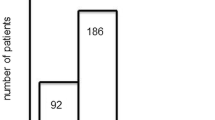Abstract
Prospective study carried out on 24 consecutive patients with Crohn’s Disease, using sonography to assess changes caused by biological therapy and its relationship with the clinical-biological response. The Crohn’s Disease Activity Index, the plasma concentration of C-reactive protein and abdominal sonograms (to assess the thickness and Doppler flow grade of the bowel wall and to detect the presence of any complications) were carried out one week prior to the induction treatment and two weeks after. The biological therapy induced remission or a partial response in 46% and 25% of the patients, respectively. It also caused a significant reduction in the thickness of the bowel wall (P = 0.005) and Doppler flow (P = 0.02), leading to the disappearance of complications in 50% of the patients. Sonographic changes were significantly more marked in patients who achieved some type of clinical-biological response, in such a way that sonograms were improved in 65% (P = 0.001) and complications disappeared in 100% of patients (P = 0.005) compared to those patients who did not respond to treatment. However, sonographic normality was only achieved in five out of 17 (29%) reactive patients (P = 0.27). This fact may support the use of sonography as a technique for optimizing the biological treatment of Crohn’s Disease.


Similar content being viewed by others
References
Rutgeerts P, Van Assche G, Vermeire S. Optimizing anti-TNF treatment in inflammatory bowel disease. Gastroenterology. 2004;126:1593–1610. doi:10.1053/j.gastro.2004.02.070.
Clark M, Colombel JF, Feagan BC, et al. American Gastroenterological association consensus development conference on the use of biologics in the treatment of inflammatory bowel disease, june 21–23, 2006. Gastroenterology. 2007;133:312–339. doi:10.1053/j.gastro.2007.05.006.
Lichtenstein GR, Abreu MT, Cohen R, Tremaine W. American Gastroenterological Association Institute technical review on corticosteroids, inmunomoduladors, and infliximab in inflammatory bowel disease. Gastroenterology. 2006;130:940–987. doi:10.1053/j.gastro.2006.01.048.
Rutgeerts P, Van Assche G, Vermeire S. Review article: infliximab therapy for inflammatory bowel disease–seven years on. Aliment Pharmacol Ther. 2006;23:451–463. doi:10.1111/j.1365-2036.2006.02786.x.
Doménech E, Hinojosa J, Nos P, et al. Clinical evolution of luminal and perianal Crohn’s disease after inducing remission with infliximab: how long should patients be treated? Aliment Pharmacol Ther. 2005;22:1107–1113. doi:10.1111/j.1365-2036.2005.02670.x.
Van Bodegraven AA, Sloots CE, Felt-Bersma RJ, Meuwissen SG. Endosonographic evidence of persistent of Crohn’s disease associated fistulas alter infliximab treatment, irrespective of clinical response. Dis Colon Rectum. 2002;45:39–45. doi:10.1007/s10350-004-6111-6.
Van Assche G, Vanbeckevoort D, Bielen D, et al. Magnetic resonance imaging of the effects of infliximab on perianal fistulizing Crohn’s disease. Am J Gastroenterol. 2003;98:332–339. doi:10.1016/S0002-9270(02)05909-9.
Poritz LS, Rowe WA, Koltun WA. Remicade does not abolish the need for surgery in fistulizing Crohn’s disease. Dis colon Rectum. 2002;45:771–775.
Haber HP, Busch A, Ziebach R, Stern M. Bowel wall thickness measured by ultrasound as a marker of Crohn’s disease activity in children. Lancet. 2000;355:1239–1240. doi:10.1016/S0140-6736(00)02092-4.
Spalinger J, Patriquin H, Miron MC, et al. Doppler US in patients with Crohn disease: vessel density in the diseased bowel reflects disease activity. Radiology. 2000;217:787–791.
Futagami Y, Hamura K, Hata J, et al. Development and validation of an ultrasonographic activity index of Crohn’s disease. Eur J Gastroenterol Hepatol. 1999;11:1007–1012. doi:10.1097/00042737-199909000-00010.
Haber HP, Busch A, Ziebach R, Dette S, Ruck P, Stern M. US findings correspond to clinical, endoscopic and histologic findings in inflammatory bowel disease and other enterocolitides. J Ultrasound Med. 2002;21:375–382.
Guidi L, De Franco A, De Vitis I, et al. Contrast-enhanced ultrasonography with Sonovue alter infliximab therapy in Crohn’s disease. Eur Rev Med Pharmacol Sci. 2006;10:23–26.
Lennard-Jones JE. Classification of inflammatory bowel disease. Scand J Gastroenterol. 1989;24((suppl 170)):2–6. doi:10.3109/00365528909091339.
Fraquelli M, Colli A, Casazza G, et al. Role of US in detection of Crohn disease: Meta-Analysis. Radiology. 2005;236:95–101. doi:10.1148/radiol.2361040799.
Ludwig D, Wiener S, Brüning A. Mesenteric blood flow is related to disease activity and risk of relapse in Crohn’s disease: a prospective follow-up study. Am J Gastroenterol. 1999;94:2942–2950. doi:10.1111/j.1572-0241.1999.01442.x.
Homann N, Klarmann U, Fellermann K, et al. Mesenteric pulsatility index analysis predicts response to azathioprine in patients with Crohn’s disease. Inflamm Bowel Dis. 2005;11:126–132. doi:10.1097/00054725-200502000-00005.
Parente F, Greco S, Molteni M, Anderloni A, Maconi G, Bianchi Porro G. Modern imaging of Crohn’s disease using bowel ultrasound. Inflamm Bowel Dis. 2004;10:452–461. doi:10.1097/00054725-200407000-00022.
Ruess L, Nussbaum AR, Bulas D, et al. Inflammatory bowel disease in children and young adults: correlation of sonographic and clinical parameters during treatment. AJR. 2000;175:79–84.
Ripollés T, Martínez MJ, Barrachina MM. Crohn’s disease and color Doppler sonography: Response to treatment and its relationship with long-term prognosis. J Clin Ultrasound. 2008;36:267–272. doi:10.1002/jcu.20423.
Maconi G, Sampietro GM, Cristaldi M, et al. Preoperative characteristics and postoperative behaviour of bowel wall on risk of recurrence after conservative surgery in Crohn’s disease. A prospective study. Ann Surg. 2001;233:345–352. doi:10.1097/00000658-200103000-00007.
Maconi G, Parente F, Bollani S, Cesana B, Bianchi Porro G. Abdominal ultrasound in the assessment of extent and activity of Crohn’s disease: clinical significance and implication of bowel wall thickening. Am J Gastroenterol. 1996;91:1604–1609.
Serra C, Menozzi G, Morselli Labate AM, et al. Ultrasound assessment of vascularization of the thickened terminal ileum wall in Crohn’s disease patients using a low-mechanical index real-time sacanning technique with a second generation ultrasound contrast agent. Eur J Radiol. 2007;62:114–121. doi:10.1016/j.ejrad.2006.11.027.
Author information
Authors and Affiliations
Corresponding author
Rights and permissions
About this article
Cite this article
Paredes, J.M., Ripollés, T., Cortés, X. et al. Abdominal Sonographic Changes After Antibody to Tumor Necrosis Factor (Anti-TNF) Alpha Therapy in Crohn’s Disease. Dig Dis Sci 55, 404–410 (2010). https://doi.org/10.1007/s10620-009-0759-7
Received:
Accepted:
Published:
Issue Date:
DOI: https://doi.org/10.1007/s10620-009-0759-7




